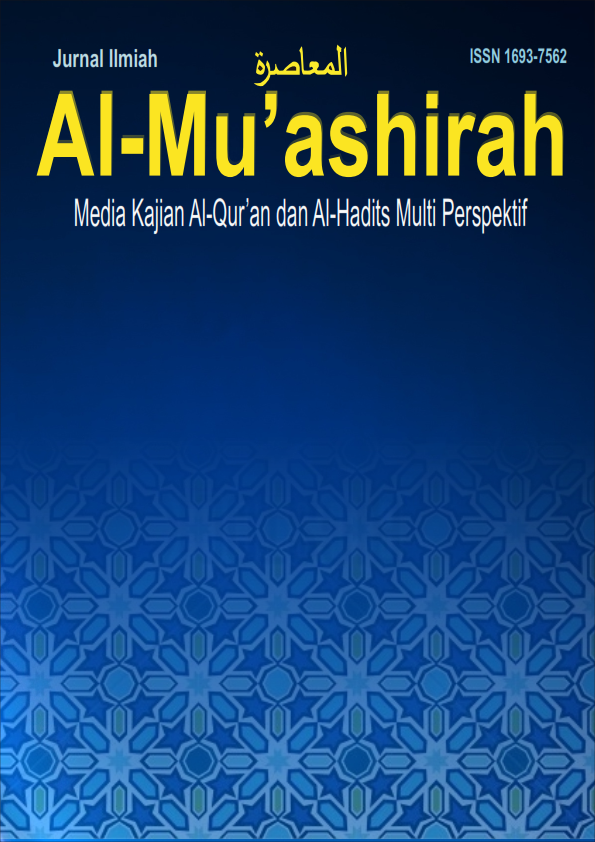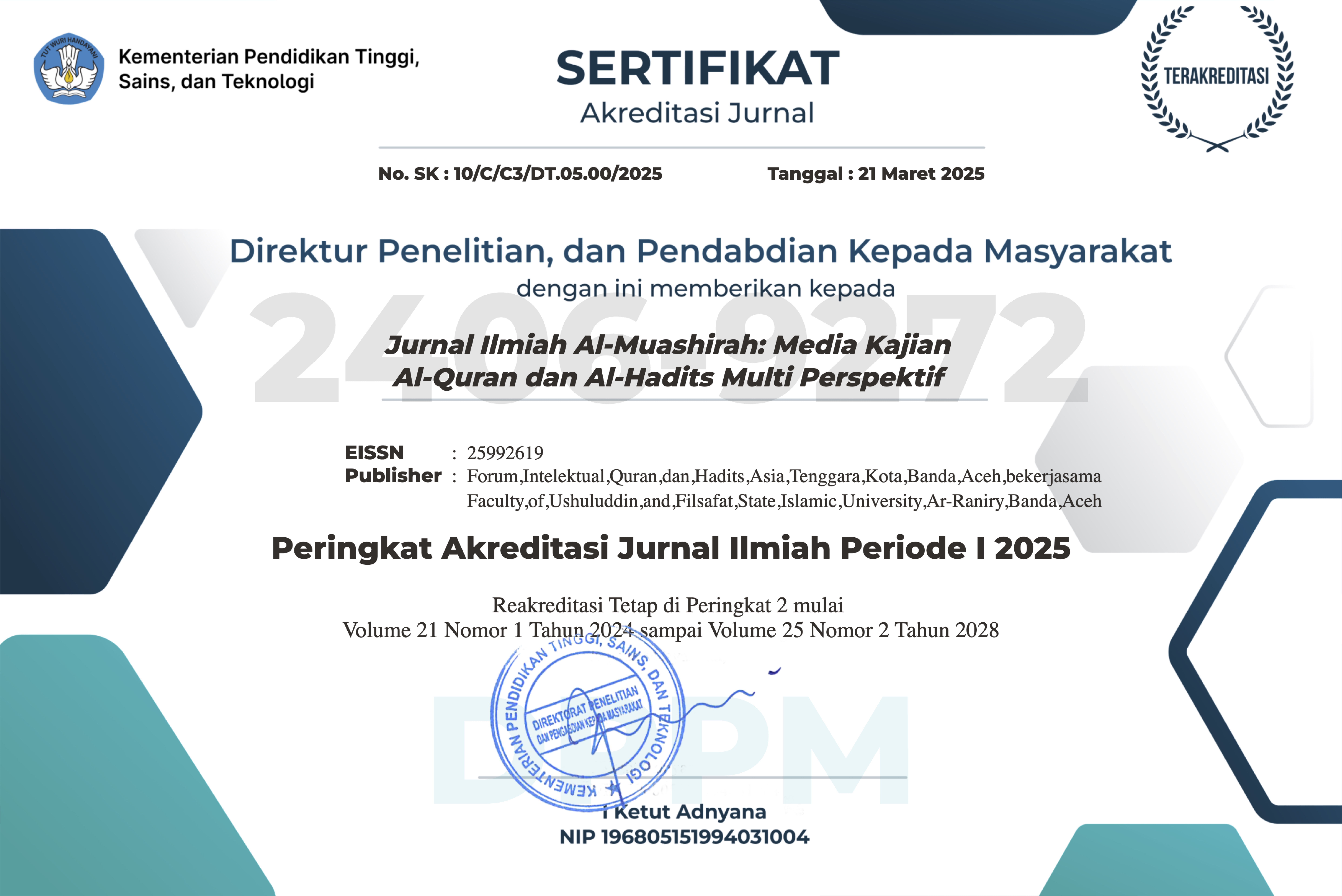Taujih al-Qiraat and Its Hermeneutical Implications in Surah Yunus
DOI:
https://doi.org/10.22373/jim.v22i2.32072Keywords:
Taujih al-Qiraat, Qurʾanic Hermeneutics, Linguistic Verification, Surah YunusAbstract
This study examines the phenomenon of taujih al-qiraat and its hermeneutical implications in Surah Yunus, focusing on how variations among the ten canonical Qur'anic readings generate layers of linguistic and theological meaning. It identifies forty-one loci of farsh al-huruf and verifies them through four parameters: rasm (orthographic framework), dabt (diacritical precision), lughawi (lexical plausibility), and nahwi/sarfi (grammatical and morphological validity). The research adopts a descriptive-analytical method integrating classical philology with modern linguistic verification to establish a transparent and replicable model of analysis. The results show that the variants in Surah Yunus function as a structured system of semantic plurality rather than random recitational differences. Ten representative loci reveal that phonetic variations preserve the rhythm of recitation, minor semantic variations influence rhetorical emphasis, and major semantic variations shape theological interpretation. These findings confirm that taujih al-qiraat serves as both a linguistic and hermeneutical framework linking structure and meaning in the Qur'an. The study concludes that the diversity of readings in Surah Yunus reflects divine intentionality within the boundaries of the Arabic language. By aligning classical verification with contemporary analysis, it offers a verifiable model for understanding how linguistic variation contributes to the Qur'an’s interpretive depth and theological coherence.
Downloads
References
ʿAbd al-Fattāḥ al-Qāḍī. Al-Budūr al-Zāhirah fī al-Qirāʾāt al-ʿAshr al-Mutawātirah min Ṭarīqay al-Shāṭibiyyah wa al-Durrāh. Cairo: Dār al-Kutub al-ʿArabiyyah, 1999.
ʿAbd Muhaimin b. Aḥmad, et al. “Peranan Ḥadīth dalam ʿIlm al-Taujīh al-Qirāʾāt: Analisis terhadap Kitab Ḥujjat al-Qirāʾāt karya Ibn Zanjalah.” Maʿālim al-Qurʾān wa al-Sunnah 16, no. 2 (2020): 90–101. https://doi.org/10.33102/jmqs.v16i2.233.
ʿAbduh al-Rājī. Al-Lahjat al-ʿArabiyyah fī Qirāʾāt al-Qurʾāniyyah. Alexandria: Dār al-Maʿrifah al-Jāmiʿiyyah, 1998.
Abū ʿAmr al-Dānī. Al-Taysīr fī al-Qirāʾāt al-Sabʿ. Cairo: Dār al-Kutub al-ʿArabiyyah, 1995.
Abū ʿAlī al-Ḥasan b. ʿAbd al-Ghaffār al-Fārisī. Al-Ḥujjah fī ʿIlal al-Qirāʾāt al-Sabʿ. Beirut: Dār al-Kutub al-ʿIlmiyyah, 2007.
Abū Ḥayyān, Muḥammad b. Yūsuf. Tafsīr al-Baḥr al-Muḥīṭ, vol. 6. Beirut: Dār al-Kutub al-ʿIlmiyyah, 1993.
Aḥmad b. Muḥammad al-Shāwī. Ḥāshiyat al-Shāwī ʿalā Tafsīr al-Jalālayn, vol. 2. Beirut: Dār al-Fikr al-ʿIlmiyyah, 1993.
Aḥmad Syatori. “Interpretasi Sufistik dalam Al-Qur’an (Telaah Kritis Penafsiran Sufistik atas Ayat-Ayat Al-Qur’an).” Jurnal Dialogis Ilmu Ushuluddin 10, no. 2 (2020): 208–19.
Al-Qurṭubī, Muḥammad b. Aḥmad. Al-Jāmiʿ li Aḥkām al-Qurʾān, vol. 2. Beirut: Muʾassasat al-Risālah, 2006.
Al-Rāzī, Fakhr al-Dīn. Mafātīḥ al-Ghayb, vol. 12. Beirut: Dār Iḥyāʾ al-Turāth al-ʿArabī, 1420 H / 1999 CE.
Al-Suyūṭī, Jalāl al-Dīn. Al-Itqān fī ʿUlūm al-Qurʾān, vol. 1. Beirut: Dār al-Kutub al-ʿIlmiyyah, 1998.
———. Lubāb al-Nuqūl fī Asbāb al-Nuzūl. Cairo: Muʾassasat al-Thaqāfiyyah, 2002.
Al-Ṭabarī, Muḥammad b. Jarīr. Jāmiʿ al-Bayān ʿan Taʾwīl Āy al-Qurʾān, ed. ʿAbd Allāh b. ʿAbd al-Muḥsin al-Turkī. Beirut: Muʾassasat al-Risālah, 2000.
Dye, Guillaume. “Concepts and Methods in the Study of the Qurʾān.” Religions 12, no. 8 (2021): 599. https://doi.org/10.3390/rel12080599.
Effendi, Sofian. “Analisis Ragam Qirāʾāt dan Implikasinya terhadap Penafsiran.” Jurnal Al-Fanar 4, no. 1 (2021): 1–16. https://doi.org/10.33511/alfanar.v4n1.1-16.
Ibn al-Jazarī, Muḥammad b. Muḥammad. Al-Nashr fī al-Qirāʾāt al-ʿAshr. Beirut: Dār al-Kutub al-ʿIlmiyyah, 1998.
Ibn Kathīr, Ismāʿīl b. ʿUmar. Tafsīr al-Qurʾān al-ʿAẓīm, vol. 1. Riyadh: Dār Ṭayyibah li al-Nashr, 1999.
Ibn Zanjalah, ʿAbd Allāh b. ʿAbd al-Muʾmin. Ḥujjat al-Qirāʾāt, ed. ʿAbd al-ʿAlīm al-Ḥarāsī. Cairo: Dār al-Kutub al-ʿArabiyyah, 1985.
Jibrel al-Saudi. “Translation of Polysemous Meanings of the Word ‘Qaḍā’ (قضى) in the Holy Qurʾān: An Analytical Semantic Study.” Dirasat: Human and Social Sciences 50, no. 2 (2023): 265–74.
Kaltsum, Lilik Ummi. “Shifting the Urgency of the Inclusion of Variety of Qirāʾāt in the Interpretation Literature.” Dialogia 19, no. 2 (2021): 430–62. https://doi.org/10.21154/dialogia.v19i2.2795.
Mannaʿ Khalīl al-Qahṭān. Mabāḥith fī ʿUlūm al-Qurʾān. Beirut: Maktabat al-Maʿārif, 1992.
Mohamed Fathy Abdelgelil et al. “Arabic Syntactic Rules with Reference to Quranic Qurraʾ.” International Journal of Academic Research in Business and Social Sciences 11, no. 7 (2021): 1707–11. https://doi.org/10.6007/ijarbss/v11-i7/10463.
Muḥammad Ṣādiq Qamhāwī. Ṭalāʾiʿ al-Baṣrī fī Taujīh al-Qirāʾāt al-ʿAshr. Cairo: Dār al-ʿAqīdah, 2008.
Quraish Shihab, M. Al-Lubāb: Makna, Tujuan, dan Pelajaran dari Surah-Surah al-Qurʾān, vol. 1. Jakarta: Lentera Hati, 2012.
Shuruq Naguib. “And Your Garments Purify: Tahāra in the Light of Tafsīr.” Journal of Qurʾānic Studies 9, no. 1 (2008): 59–85. https://doi.org/10.3366/jqs.2007.9.1.59.
Downloads
Published
Issue
Section
License
Copyright (c) 2025 Eka Prasetiawati (Author)

This work is licensed under a Creative Commons Attribution-ShareAlike 4.0 International License.
Authors who publish in Jurnal Ilmiah Al-Mu'ashirah agree to the following terms:
- Authors retain copyright and grant the journal right of first publication with the work simultaneously licensed under a Attribution-ShareAlike 4.0 International (CC BY-SA 4.0) License that allows others to share the work with an acknowledgment of the work's authorship and initial publication in this journal.
- Authors are able to enter into separate, additional contractual arrangements for the non-exclusive distribution of the journal's published version of the work (e.g., post it to an institutional repository or publish it in a book), with an acknowledgment of its initial publication in this journal.
- Authors are permitted and encouraged to post their work online (e.g., in institutional repositories or on their website) prior to and during the submission process, as it can lead to productive exchanges, as well as earlier and greater citation of published work (See The Effect of Open Access).














